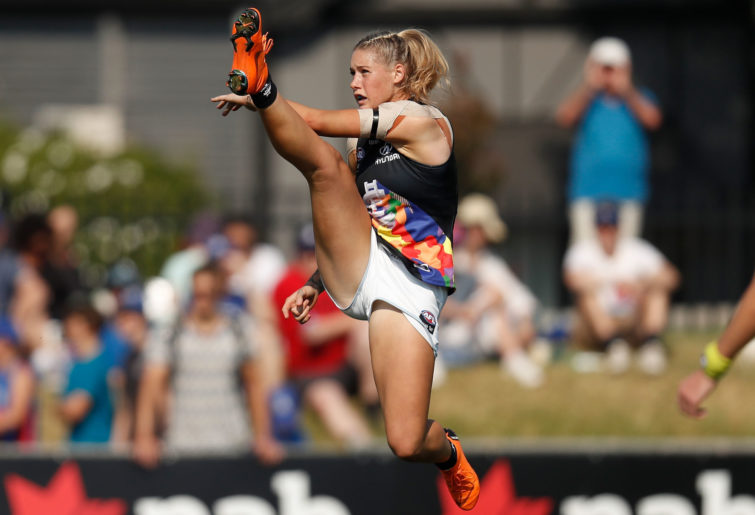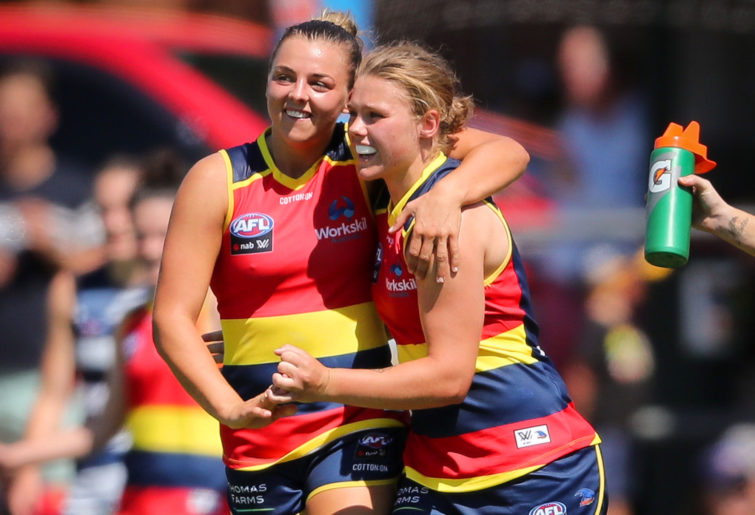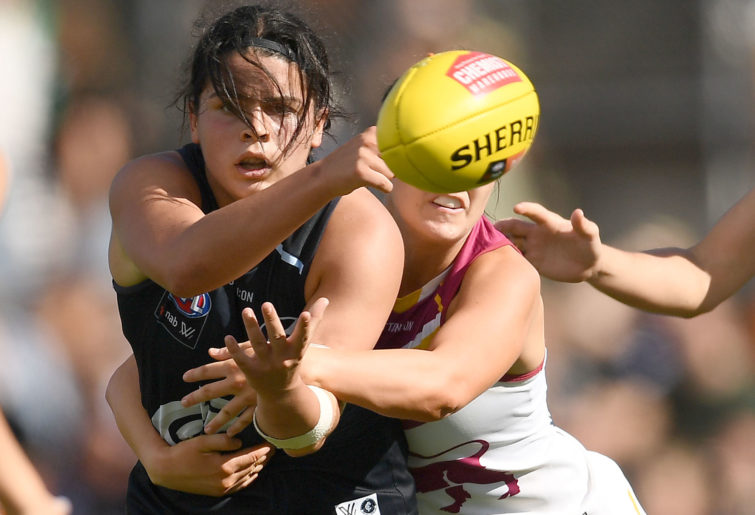Season 2019 has been whittled down to just two teams with the Adelaide Crows and Carlton Blues to do battle for the premiership at Adelaide Oval on Sunday.
Today we’ll preview the grand final – but first, let’s talk about the semi-finals played on the weekend past.
Carlton Blues versus Fremantle Dockers
In hindsight, after hearing Trent Cooper talk in the post-game presser, it seemed obvious that Carlton would win. Fremantle talked a good fight right up until the game, but they were hurting.
Dana Hooker never really recovered from her sternum injury and leg knock, and finished with only 12 disposals.
Sabreena Duffy’s ankle was always touch-and-go, and of course the backline was missing Alex Williams with an ACL from the week before.
Worse yet, Kara Donnellan — who had been battling knee soreness all season — was withdrawn just before the game, leaving Freo’s midfield very short from the beginning.
Then, when the game started, a series of new injuries sent Ashley Atkins, Evie Gooch and Haley Miller to the bench for some period, plus others, and Fremantle began to look like the walking wounded.
Carlton, remarkably, have hardly had an injury all season, and simply ran the Dockers off their feet.
I said last week in previewing this game that we haven’t seen the best of the Blues yet, and sure enough, in this game they showed that their top level might be as good as any team in the competition.
They lost games early because the sheer scale of the transition Dan Harford was asking them to make, from last season’s dismal showing to this one, with lots of new players and playing style.
But all the pieces are starting to click together now, and the Crows may just have a fight on their hands for the premiership.
The midfield unit of Madison Prespakis, Bri Davey, Chloe Dalton and Amelia Mullane won a lot of contested ball, and Allison Downey deserves special credit, dominating hitouts (I’d tell you by how much, but the AFLW website won’t say) and gathering 13 possessions.
Rather than trying to fitness the hitouts, Downey would often punch long to space and let her outside mids run onto it, thus bypassing much of Fremantle’s midfield tackling pressure.
I thought going in that Fremantle’s midfield run would be too much, but without Donnellan, and with Hooker on one leg and Kiara Bowers struggling with a Jess Edwards tag, it was the other way around.
Better yet for the Blues, Lauren Brazzale, who’d been averaging 10 possessions this season, stepped up with 22, playing effectively as a midfielder and dominating.
And then of course there was Tayla Harris, who showed the temperament all sports fans look for in a champion player — the love of the big occasion, and the lift in standard because of it.
If it wasn’t Harris’s best game ever, it was very close — she only kicked one goal but took multiple contested marks, set up a number more goals, and led by general inspiration, crashing packs and intimidating every Docker who had to stand under a high ball and sweat.
Deprived of their midfield run the Dockers’ key position players couldn’t get into the game, with Ebony Antonio, Kellie Gibson and Gemma Houghton all quiet — though Houghton was the best of these, and will be a big target for West Coast recruiters in the offseason.
Once again in the AFLW, so much of the result comes down to the midfield matchups, and in this one, the Dockers got crushed.
It’s worth taking a moment to reflect on Fremantle’s season, and what a great job Trent Cooper and the coaching staff have done with the team this year.
It’s also a sad reflection, because next year there might not be a lot of this team’s starting lineup left, with expansion teams allowed to take up to eight Fremantle players, the bulk of which will likely be taken by West Coast.
Of course, it’s possible none of the Fremantle girls will leave, but given that the Eagles remain the dominant force in Western Australian football, it seems more likely that Fremantle will be far less competitive next year, and possibly for several years after.
Given two teams fighting over an as-yet inadequately sized talent pool, it’s possible that this 2019 Fremantle run is the last time we see a Western Australian women’s team in the finals for several years at least.

(Photo by Michael Willson/AFL Media)
Adelaide Crows versus Geelong Cats
It would be cruel to suggest that the score flattered Geelong, given that they lost by 73 to 7. But the Cats were truly lucky to score at all, as both scores were free kicks, and the goal came from a fifty-meter penalty.
The match went pretty much as I’d feared, with Geelong playing just well enough in the one facet of the game they’re good at — defensive on-ball pressure — to make the game scrappy, but still losing by so much as to make a mockery of the concept of a final being a contest between the league’s best teams.
That’s not Geelong’s fault, of course — as a team they’re simply not ready for finals, everyone knew it, and this result proved it.
They got in because of the conference system, but I’m getting tired of having to talk about that, so let’s not bother.
Instead, let’s look at the reason Geelong still finished second in Conference B, ahead of Brisbane, GWS and Collingwood.
There was a day not long ago in the AFLW when on-ball pressure alone could be enough to win you lots of matches. Geelong are a little odd in 2019 in that coach Paul Hood, alone of the five new coaches in the competition, decided to stick with a 2018 style of play.
One could argue that it took him to a semi-final and thus was a success, but more objectively, Hood’s record is the least impressive of all the new coaches this season, and not just because of this scoreline.
Geelong’s pressure on Adelaide was more about shutting down Adelaide’s movement than it was about moving the ball themselves.
And you could see it, with Geelong players hanging onto their direct opponents point-blank, clogging up the passing lanes, and achieving some level of success at disrupting Adelaide’s skill level, which was uncharacteristically sloppy for much of the match.
But when you achieve all of these objectives, yet still lose the game by 66 points, you have to conclude that the objectives weren’t worth achieving in the first place.
Adelaide weren’t as interested in attacking Geelong’s players and slowing them down as they are simply in getting the ball.
Their hands weren’t that clean at the contest, and many times Geelong players tackled them before they could go anywhere, but always the Crows were driving it forward, following up, running in support, relentlessly heading toward goal.
It’s becoming apparent that the close-range handball in traffic is one of the most important skills in women’s football, mostly because it remains so rare.
Too often Geelong players would take possession in traffic and tuck the ball under their arm with no thought of passing, only to be predictably flattened.
Adelaide, by comparison, are always looking to handball, and never look surprised when they’re tackled.
When Geelong got caught with the ball, everything stopped, whereas when Adelaide got caught with the ball, the ball kept moving.
It’s a skill not enough AFLW players have learned, and two of the three teams best at it (the other being Melbourne) are now in the grand final.
Of course, one can’t put all the blame on Geelong’s playing style. The Cats’ top players are excellent (Olivia Purcell, Meg MacDonald, Richelle Cranston, Cassie Blakeway, Mel Hickey) and some of their juniors will be great eventually (Denby Taylor, Rebecca Webster, Sophie Van de Heuvel) but there just aren’t enough of them.
And also, even their best were struggling for speed against the Crows, who often seemed to be running rings around them, evading tackles at will and treating opponents with contempt.
Geelong need to get faster, and it’s entirely possible that even had they played a more attacking style, it wouldn’t have worked any better than this because the players just aren’t fast enough to make it work.
Geelong will now follow the more traditional development path of an expansion team, building gradually and relying on draft picks to develop the young talent on their list.
In the NAB League Girls competition (as the TAC Cup is now called) the Geelong Falcons are once again winning games by large margins, and some star juniors from other teams look likely to be Cats-bound as well (Murray Bushrangers star Millie Brown, daughter of former Cat Paul Brown, for one).
They have a strong core to build around, this year’s juniors will be significantly better next year, and this season’s best player, Nina Morrison, will hopefully be back fully fit to give them that Maddy Prespakis-like star power through the middle of the ground.
The Cats’ time is coming.

(Photo by AFL Media)
Grand Final preview
Conventional wisdom says Adelaide should win, but having seen what I saw last weekend, I’m not so sure.
Both Geelong and Fremantle play very tight pressure around the ball, but of Adelaide and Carlton, I thought Carlton handled it better.
Carlton have the best fast handballing around the stoppages that I’ve seen this season, and it was on full display against Fremantle.
Prespakis has some of the best hands in the competition, Davey isn’t far behind, and even Chloe Dalton, despite her unfamiliarity with handballs, seems to have brought with her the rugby instinct to move it on quickly in traffic.
Erin Phillips has that ability, but Ebony Marinoff prefers to run clear and kick, and Anne Hatchard’s hands aren’t quite at that level either — her strength this season being physical power and running ability.
If the ball gets outside, Phillips, Marinoff and Hatchard are dangerous, but in close, with ball movement at least, Carlton might have the edge.
In the ruck, Jess Foley’s been very good this season, but Allison Downey’s been playing this game a lot longer and had a blinder against Fremantle, so one more edge to Carlton at the clearances.
When it comes to outside run, both might be equal — Carlton probably have an edge for sheer speed, but the Crows have more bigger, harder-tackling bodies, and more consistency in their skills with the ball.
Offensively I think Carlton and Adelaide’s midfields are about even, but the edge in defensive pressure has to go to Adelaide, and that’s an area where Carlton faced a massively under-strength Fremantle in the semi-final.
So an overall, assuming Carlton play to the same standard as last week, about even.
Perhaps Carlton’s biggest worry going into this game is what to do about Adelaide’s forward line. Kerryn Harrington has been the Blues’ best defender this season, and is reported to be okay after suffering a shoulder injury in the semi-final.
If she’s fit, she’s a good chance to run with Erin Phillips when she goes forward, but that’s difficult to coordinate because Phillips plays midfield as well, necessitating a switch-off with another Carlton player.
Carlton’s backline are at least fast, and did a great job of not allowing the Fremantle forwards to get behind them in the semi-final, something few backlines have managed this season.
They’re going to need all of that speed against Adelaide’s forwards, but those forwards present special challenges because they’re all so different — Chloe Scheer is powerful, Stevie Lee Thompson is fast, Eloise Jones is agile with elite skills and Danielle Ponter is mercurial, capable of manufacturing goals from nothing.
Furthermore, Carlton play a much more open style than do Geelong, so those Adelaide forwards will find much more room to move — circumstances in which they excel.
Carlton’s gameplan, unlike Geelong’s, is to win the ball themselves and get so many forward entries and scores that they don’t have to spend as much time worrying about Adelaide’s forwards.
They possess the midfield power to do this, and the forward line to kick those goals, though Adelaide’s backline won’t make it easy.
Chelsea Randall seems the obvious choice to go with Tayla Harris, and while restricting Randall to a shut-down defensive role might limit her run and rebound, Harris’s recent form might leave Adelaide with no choice.
Sarah Allen is possibly the unsung star of the Adelaide team in the backline, tall, strong and rarely beaten — but Carlton’s most threatening forwards are fast and agile, like Adelaide’s, so Allen might be best used on Bree Moody, who’s also tall, and has been kicking goals lately for Carlton.
Adelaide will then need to contend with Brooke Walker and Darcy Vescio, the latter of whom probably needs to lift from recent form, having lost some of her claim to being a A-list forward this season.
At her best, Vescio is capable of dazzling, but opportunistic small forwards can’t afford to make many mistakes, and this season her hands haven’t been that great.
She’s had only five goals this season from eight games, the same number she kicked in seven games last year, and her disposal efficiency is only 55 percent, less than rugby converts Brooke Walker (57 percent) and Chloe Dalton (61 percent).
Frankly, right now Vescio is the least dangerous of Carlton’s forwards. If that were to change in the Grand Final, Adelaide’s defenders could find themselves with one more dangerous forward than they’re capable of stopping, and the Crows could be in for a monumental shock.

(Photo by Quinn Rooney/Getty Images)
Keys to the game
Erin Phillips
We all know she’ll play well, but if by some chance Carlton can find a way to limit her influence, that could swing the game.
Likely Jess Edwards will get the tagging role… but maybe Edwards’ efforts would be better spent on Ebony Marinoff? Slowing Marinoff (the highest disposal-getter in the league) might actually be achievable while stopping Phillips is probably not.
Carlton’s midfield
Adelaide’s midfield is going to be rock solid, as the evolution of Anne Hatchard to A-list level has turned them into a brutal combination.
Carlton’s midfield have been much less stable this season, and thus could be more vulnerable.
If Adelaide decisively beat the Blues in the middle, the Carlton forwards won’t see enough of the ball, the Adelaide forwards will see too much, and it’ll be game over.
Carlton’s B-list
Not to be mean, but some players are better than others, particularly with ball skills.
Carlton’s best ball users are as elite as anyone in the women’s game, but there are some others who, this season, have struggled for consistency.
Yes, they’ve gotten steadily better as the season’s gone on, but playing Adelaide in a Grand Final at Adelaide Oval is perhaps the biggest test of a player’s nerves its possible to imagine.
If Carlton’s occasional kick-sprayers can hold their nerve and kick straight, the Blues have a real chance. If not, then they’ll discover there’s no team you’d less like to have midfield turnovers against than the Crows.
Prediction
Adelaide by a goal, but if Carlton play at their best, could easily go the other way.































































































